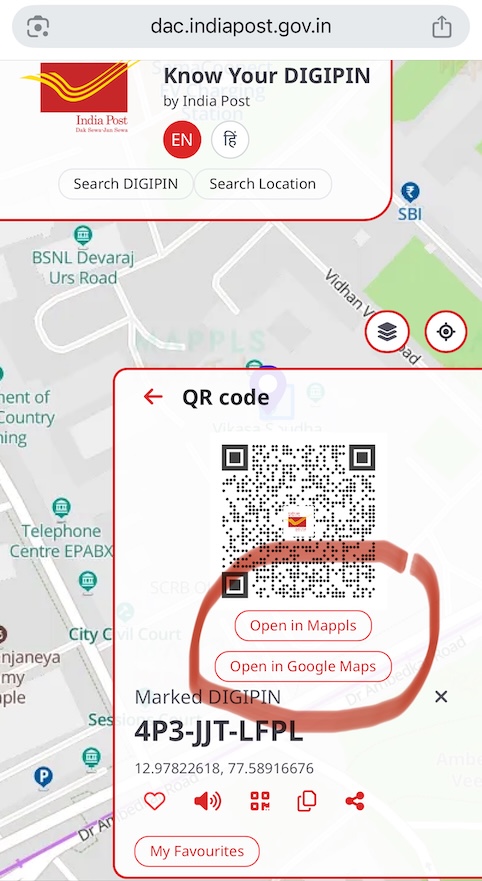In India, addresses have always been quirky — full of old door numbers, floating landmarks, ambiguous locality names. Citing kamat.com,
| Ramachandran Srinivasan #610, “Rajalaxmi”, Behind Kantaraj Urs Road Mysore The Doddabudhi Family Near Mahajana College Jayalaxmipuram, Mysore J.S. Nisar Ali ka Bagicha Near Vaibhav Theatre Jabbalpur Mr. Shenoy House No. 1136, Upstairs N. R. Colony Bangalore | Shanbhags Opposite Railway Track Shimoga Sadanand S. C/o Car Street Near Ganapati Temple Honavar Deshpandes Behind ‘Little Flower School’ Gulbarga Karnads No. 8/2, 2nd Floor Above Balaji Stores Swimming Pool Extension Bangalore |
We usually refer to landmarks, door numbers (old door number & new door number in the same address). Those addresses were fine when everyone knew their local geography. Times have changed, and I think the physical addresses have evolved over the decades. But in today’s digital, on-demand world — with GPS, e-commerce, ride-sharing and logistics — we need something that works reliably, consistently and unambiguously.

I have found that co-ordinates of DIGIPIN (Digital Postal Index Number) gets the user to the correct location more effectively. When it comes to pinpointing the location, DIGIPIN is better. I say this because people are usually on the parallel street of my home and office when I shared the Google Maps location. Users never lost their way when they used DIGIPIN.
The traditional 6-digit PINCODE is making way for the DIGIPIN — a 10-character alphanumeric digital code that pinpoints your exact geographic location. DIGIPIN is a geospatial reference system developed by the Department of Posts, in collaboration with IIT Hyderabad and ISRO’s NRSC.
DIGIPIN as a Digital Public Infrastructure
The Policy Document from India Post provides detailed insights into the Digital Hub for Reference & Unique Virtual Address (DHRUVA) – the proposed DPI for address information management in India. It includes the design principles, key interfaces, and the legal and policy safeguards necessary for its safe and effective functioning.
DIGIPIN contains the geographic location of the area. It is possible to extract the latitude and longitude of the address from the DIGIPIN with low complexity. Quoting from the technical document of DIGIPIN,
“DIGIPIN is visualised as an alphanumeric offline grid system that divides the geographical territory of India into uniform 4-meter by 4-meter (approx.) units. Each of these 4m x 4m units (approx) is assigned a unique 10-digit alphanumeric code, derived from the latitude and longitude coordinates of the unit.”
The technical document includes code for converting,
- latitude-longitude as input and encodes it into a 10 digit alphanumeric code
- a 10 digit alphanumeric code (DIGIPIN) as input and encodes it into degree-decimal coordinates (latitude, longitude). Google Maps and Mappl apps are using this data to show you the route to your destination.
The application world should use the above APIs to strengthen its product further. The image below shows how multiple 3rd party mapping apps can use the coordinates calculated by DIGIPIN. The recipient of the location can decide which is her favorite maps app, instead of being forced to use only a particular mapping app.

What has to happen for DIGIPIN to become popular
1. Embed DIGIPIN in everyday B2C apps
Major consumer-facing apps should adopt DIGIPIN as a location field. Examples:
- Ride-hailing apps (e.g., Ola, Uber)
- Food delivery apps (e.g., Swiggy, Zomato)
- Package delivery/courier apps (e.g., Porter)
- E-commerce check-out flows (e.g., Amazon, Flipkart)
When each of these has an “Enter YOUR DIGIPIN” field, it becomes habitual for users, and the data set grows.
2. Make government and corporate addresses publish DIGIPIN
Every government office, public institution, and corporate office should start publishing their DIGIPIN alongside their physical address. For example: “Office of Registrar — DIGIPIN: ABC-123-4XYZ”.
We have added DIGIPIN to Sahamati’s visiting cards — that’s exactly the kind of small change that drives awareness.
3. Introduce browser/mobile linkability for DIGIPIN
Right now, addresses use mailto: (RFC 6068) and tel: (RFC 3966) URI schemes in HTML so that clicking them opens the email app or phone dialer.
Likewise, if we had a digipin: URI scheme (for example: digipin:ABC-12X-Y34Z) that would open the default maps app at that location — we reduce friction for users. Mappls already recognizes the code — that’s promising.
Implementation ideas:
- Propose an IETF‐style draft for
digipin:scheme (or integrate withgeo:) - Work with browsers, web standards, and mobile OSes so that
digipin:links become clickable - Provide plugins/extensions for popular CMS systems so content creators can embed DIGIPIN links easily
4. Launch awareness & incentive campaigns
Technology alone doesn’t guarantee adoption — you need user awareness and motivation. Here are several sub-ideas:
- Public awareness drives: Posters, social media, video ads explaining what DIGIPIN is and why it makes life simpler (“No more finding your house behind the tall coconut tree!”)
- Incentivise usage by early adopters: For example, logistic companies could offer free or discounted delivery if you input your DIGIPIN.
- Gamify adoption: Apps could reward users for verifying their address via DIGIPIN or tagging their delivery location using DIGIPIN.
- Partner with e-commerce & payments platforms: During checkout, show “Have a DIGIPIN? Enter it — faster delivery”.
- Educate local small businesses: Many local stores and service providers still rely on landmarks. Educating them to ask for and publish their DIGIPIN will increase visibility at the grassroots.
5. Build developer ecosystem & integrations
For DIGIPIN to scale, developers need tools and APIs. Steps:
- Provide a clean, well-documented API for converting between lat/long and DIGIPIN code
- Open developer contests/hackathons (e.g., “Build an app that uses DIGIPIN to optimise delivery routes”)
- Encourage integration with IoT devices, asset-tracking etc.
- Publish SDKs for major platforms (Android, iOS, Web) and sample code showing how to embed a DIGIPIN map link.
- Showcase success stories (case studies) of companies adopting DIGIPIN and improving their operations.
6. Ensure data quality & trust
Adoption only sticks if users trust the system. Therefore:
- Ensure the DIGIPIN portal is reliable, secure, and easy to use.
- Make it easy for users to claim their address, correct errors, update location if needed.
- Provide offline support / low-bandwidth-friendly versions so remote users can use them.
- Monitor misuse (fraudulent codes or duplicate addresses) and put governance in place.
- Build open data or publish an anonymised dataset so other services can plug into it (while respecting privacy).
Get your own DIGIPIN by visiting the website here! And don’t merely generate your DIGIPIN, start using it!
Leave a Reply